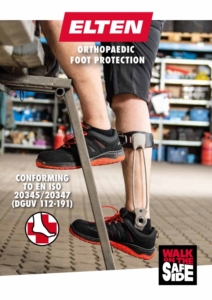ORTHOPAEDIC FOOT PROTECTION ACCORDING TO EN ISO 20345/20347 (DGUV 112-191)
REQUIREMENTS FOR ORTHOPAEDIC SAFETY SHOES
The new EN ISO 20345/20347 standard from 2022 sets out detailed requirements that apply to the manufacture of safety shoes and boots, including those with orthopaedic foot protection. Appendix A differentiates between 3 types of orthopaedic modifications to safety footwear:
Type 1 — Fitted with trimmed insoles
Type 2 — Modified safety shoes
Type 3 — Custom-made safety shoes
Special testing requirements have been defined for these three types, which increases the testing scope. In addition to changes to the scope of testing, the labelling requirements for safety shoes with orthopaedic fittings and orthopaedic insoles are also changing. Before the introduction of EN ISO 20345/20347, the requirements for orthopaedic foot protection were set out in DGUV Rule 112-191. DGUV Rule 112-191 (formerly BGR 191) addresses the use of foot and knee protection. It states that every time safety footwear is orthopaedically modified, checks must be carried out to ensure that it continues to comply with the requirements of the EN ISO 20345 standard in accordance with the certificate. This check must be performed by an official test institute, which then issues an EC type examination certificate. As the cost of testing individually requested orthopaedic modifications for every single pair of shoes is not economically viable, ELTEN GmbH offers a comprehensive range of safety shoes for the most common orthopaedic problems, which have been certified for this purpose in advance.


